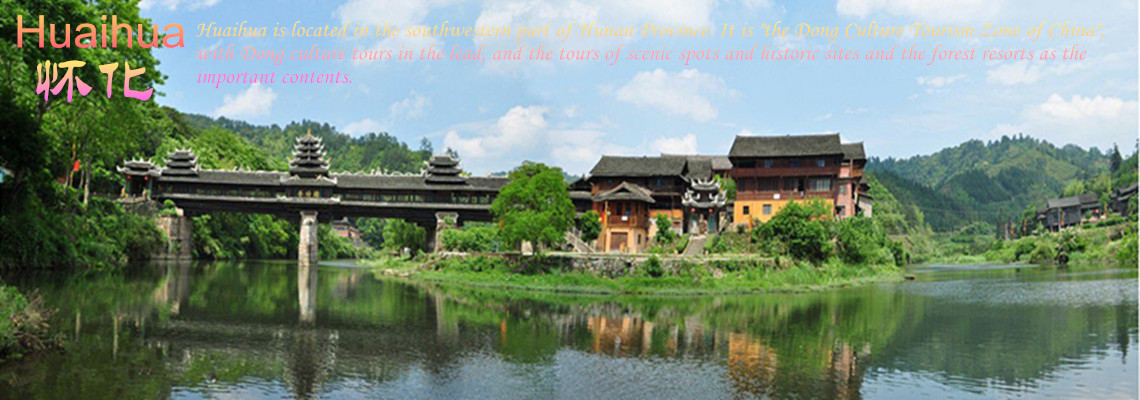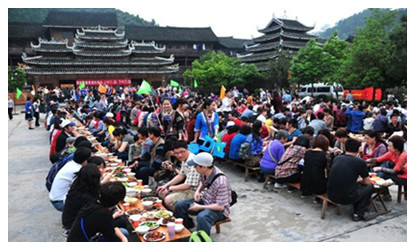
Huaihua City
 Situated in the southwest of Hunan Province, the city of Huaihua is a new city, built in the 1970s along with the construction of the Hunan-Guizhou and the Jiaozuo-Liuzhou railways. With a population of 5.1199 million, Huaihua is home of ethnic minorities, such as Dong,Miao,Yao.
Situated in the southwest of Hunan Province, the city of Huaihua is a new city, built in the 1970s along with the construction of the Hunan-Guizhou and the Jiaozuo-Liuzhou railways. With a population of 5.1199 million, Huaihua is home of ethnic minorities, such as Dong,Miao,Yao.Huaihua has a rather large industry sector that accounted for 37% of the GDP in 2015. Metallurgy, agricultural products processing, pharmaceuticals, paper making and construction materials are the leading industries. The listed Huaihua Chenzhou Mining Group is one of the major industrial enterprises in Huaihua.
The service industry is the largest economic contributor to Huaihua, accounting for 44% of the GDP in 2015. Retail and wholesale and tourism are the two important pillars of the service sector.
It was in the late Spring and Autumn Period (770BC-476BC) that the Chu State expanded its domain southward to Hunan and administrative organizations began to be formally established in this area. During the Warring State period (476BC-221BC), Qianzhong Shire was set up here, and the territory of present Huaihua City is essentially the same as in that period.
The city lies between the Xuefeng Mountains and Wuling Mountains, with mountainous areas making up a large part of Huaihua. Mountains are found mainly in the east and west, and the central region consists of ravines, plains and hills. The Yuanshui River flows through Huaihua from the south to the north. Huaihua is a veritable green city, with sixty-five percent of its territory covered by forests.
Huaihua has a subtropical, humid, monsoon climate featuring rich rainfall and moderate weather all the year around. The annual average temperature falls round 16.8 degree centigrade.
Huaihua can be visited at any time during the year and is at its best in spring, summer and autumn.
Huaihua is located in the southwestern part of Hunan Province. It is "the Dong Culture Tourism Zone of China",with Dong culture tours in the lead, and the tours of scenic spots and historic sites and the forest resorts as the important contents.
The tourist attractions in Huaihua are divided into the north, central and south sections. Those in the north feature folklore of the Dong and Miao ethnic groups and beautiful natural scenery. There are the Fenghuang Mountain Scenic Area, the Eyou Mountain Scenic Area and the Wuxi Lake with a thousand islets in it; those in the central part feature historic structures of the Dong and Miao ethnic groups, such as ancient trade city of Hongjiang, an ancient village of Gaoyi, the ancient city of Qiancheng, the ancient village of Jingping and the sheltered bridge in Longjin; those in the south are fairyland-like villages of minority peoples. Visitors can appreciate the drum towers, sheltered bridges, roadside pavilions and ancient cottages, all particular to the local inhabitants of the Dong and Miao ethnic groups. Mountains there echo with the singing of the “Grand Song” of the Dong people and the love songs of the Miao people.
The city has a good ecological environment and a majestic landscape with many sites of historical interest. The newly discovered ancient trading town at Hongjiang is well preserved. Its marketplace, business names and offices are still clearly distinguishable, and it is of high archaeological value for the study of the history of economic and social development in western Hunan.Huaihua is the major transport hub in southwestern Hunan, with three railways running through the city area. It turned the city into a major economic radiation center linked to the peripheral areas of the neighboring provinces, Chongqing Municipality and the Guangxi Zhuang Autonomous Region. In 2002, the Chinese State Planning and Development Commission and the Japanese International Cooperation Association (JICA) chose Huaihua as a case study for development strategy of medium-sized cities in the western regions of China.
In terms of area, Huaihua is the biggest city in Hunan Province. Here, Han Chinese live harmoniously with 31 ethnic groups, including the Dong, Miao, Yao and Tujia. According to historical records, the history of Huaihua dates back 300,000 years to the Paleolithic age.
Total area: 11,819 km2
Huaihua City, a total area of 27,564 square kilometres.Total population of 4.86 million (2003).Municipal People's Government in Hok Fung Ying City Road, Zip code: 418000.Administrative division code: 431200.Code: 0745.Pinyin: Huaihua Shi.



 Ask Questions ?
Ask Questions ?